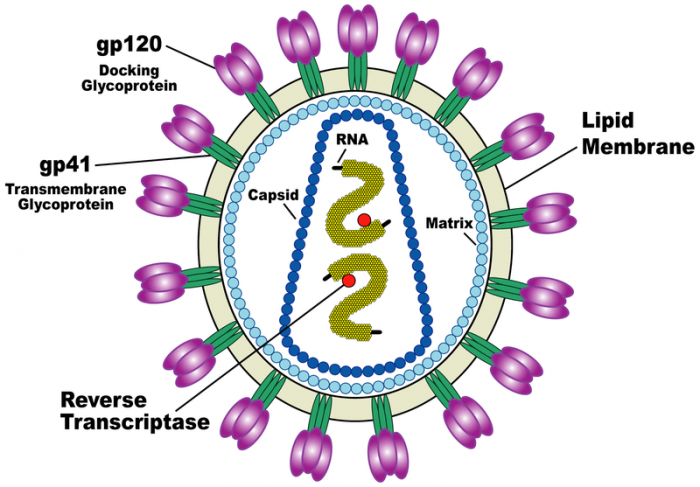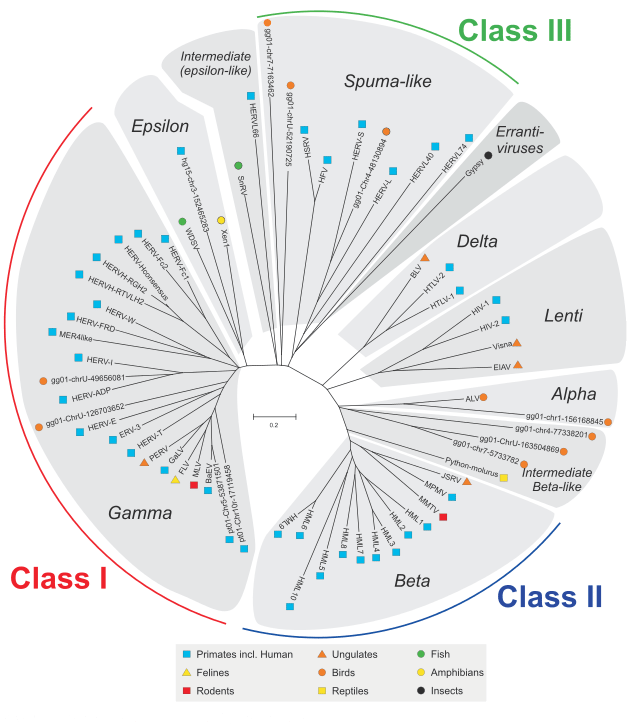
Humans are an old species and our DNA is even older. There are many things in our DNA that we have yet to understand, but as we develop better technologies we get closer to knowing their secrets. Within our DNA are remnants of our ancient ancestors from before Homo sapiens. Among those remnants are ancient viruses that took up home in our DNA.
They are found through many parts of our body but are especially prevalent in pregnant women, embryos, and cancer cells. To understand why these ancient viruses are part of us, we first need to understand what kind of viruses can enter our DNA and how we consider the many ancient parts of our DNA.
Retroviruses
The ancient viruses that are in our DNA are considered human endogenous retroviruses (HERV) and they were once retroviruses that invaded ancestor DNA. Retroviruses are viruses that contain RNA, the cousin of DNA, which encodes for genes that helps it insert itself into the host DNA. The retrovirus converts its RNA into DNA, which is then inserted into the host genome. Once it is in the host genome, the viral-DNA uses the host’s own systems to replicate itself and carry on the infection. One of the most infamous retroviruses is HIV, which we currently cannot cure. To treat most retroviruses, there are usually antiretroviral treatments such as those for HIV.

“Diagram of the HIV virus.” by the US National Institute of Health (redrawn by en:User:Carl Henderson) via Wikimedia Commons is licensed under CC0
Retroviruses can be used for positive roles in medicine or can negatively affect us. Some retroviruses cause cancer because they are mistakes when they enter the DNA. They could also cause cancer by disrupting oncogenes, or any other genes relating to cancer prevention/acceleration. These disruptions are dangerous and difficult to treat. Once modified, retroviruses can be used for gene therapy as we can use them to target defective genes. Using the lentivirus, it may be possible to insert, delete, or modify the genes in humans. These are prime candidates for treatments for diabetes and some cancers.

The different classes of ERVs that exits. “Classes of ERVs” from Wikipedia.com/Jern P, Sperber GO, Blomberg J, is licensed under the Creative Commons Attribution 2.0 Generic license.
The “Junk” in Our DNA
“Junk” DNA is a misinformed term that is used to describe the parts of our DNA that do not encode any genes. Previously, it was thought that such DNA was useless and therefore junk from the past that simply stayed with us, like vestigial organs that we no longer use. As we improved our understanding of genetics and build better genetic technologies, we realized that they did serve some purpose. Approximately 98% of our DNA does not encode for any gene and only the 2% remaining do. That represents a lot of DNA that we thought did nothing.
The Encyclopedia of DNA Elements Project (ENCODE) and other research projects helped to show that those 98% did actually do something. The ENCODE project included over 400 scientists across the world. The project found that over 80% of the “junk” DNA was biochemically active in the cells. This means that they were doing something. The project estimates that there are over 4 million gene-switches in the genome. These gene-switches are used to regulate many parts of gene expression including when they turn on and off, how much proteins are produced from it and regulate it throughout our lifetime. Understanding the different parts of this region of DNA would help us to understand genetic diseases, human aging, and many other factors associated with our DNA.
Ancient Viruses in Modern DNA
Among those “junk” DNA that we now know do things are the HERV. They contribute to about 8% of the genome and have been with us for millions of years. Most of the HERV are inactive because of years of deletions and mutations that changed the virus from its original form. It is estimated that they integrated with human ancestors and that integration was passed down from generation to generation until they became a permanent fixture of human DNA. Despite that most of the retroviral DNA are broken apart in our DNA, there are a few that remains intact. There are also some that provide some function in the human body, especially pregnant women. Scientists have identified an HERV that provides a cell layer to developing fetus, protecting it from toxins from the mother.
Researchers recently identified an HERV in the DNA of pregnant women that dates back over 100 million years ago. This particular HERV is expressed in cancers and the embryo. Heidmann and the other researchers identified the human exogenous MER34 (medium reiteration frequency family 34) ORF. It is expressed in the fetus and then released into the blood of the mother during pregnancy. The researchers found that it was highly expressed in the placenta, stem cells, and some cancers (mostly ovarian cancer). While we do not know what the role that this ancient virus played in the body, we do know that it must have been extremely important to us at one point. We know this because the retrovirus is highly conserved in our DNA, which means it has not degraded or broken apart for the past 100 million years since it entered our ancestors DNA. This is in contrary to the other ancient retroviruses that have broken apart in our DNA. Things that are this highly conserved are usually very important or played a very important role in our evolution.
Further Research
Most of the retroviruses are expressed in the developmental stage of humans and in cancer cells. This means that there may be some relations between HERV and those areas. As we deal with many different kinds of cancers that pose a threat to human health, it becomes extremely important to understand the factors that interact with them and see if any of them can act as a cure or treatment towards them. HERV also are expressed in stem cells, which is also tied to cancer cells so understanding HERV would greatly benefit us even if we do not find any cures from them. As we continue to study these matters, hopefully we can also identify the functions that many of the HERVs have because that also remains a mystery.









